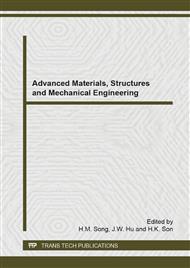p.298
p.302
p.310
p.317
p.325
p.330
p.336
p.345
p.349
Effect of Temperature on Deactivation Force of Three Commercial NiTi Orthodontic Archwires
Abstract:
Objective: The purpose of this study was to investigate the transition temperature range (TTR) and the effect of temperatures at 10, 20, 30, 40, 50 and 60 °C on the deactivation force of three commercially available NiTi archwires. Materials and methods: Three different brands of NiTi archwires, NiTi OR (Ormco), NiTi GH (G&H) and NiTi H (Highland), with a cross sectional area of 0.016 x 0.022 inch2 were analysed for transformation temperature range (TTR) by using differential scanning calorimeter and load-deflection characteristics using a three-point bending test at temperatures of 10, 20, 30, 37, 40, 50 and 60 °C. Statistical Analysis: Descriptive analysis was used to calculate each variable and Kruskal Wallis test was performed to assess the difference in measurements among the three NiTi wires. P<0.05 was considered as statistical significant. Results: TTR showed austenitic temperature finish (Af) at 24.45 °C for NiTi OR, 27.55 °C for NiTi GH and 51.5 °C for NiTi H. The highest deactivation force was found in NiTi H followed by NiTi OR and NiTi GH at the temperatures below and higher than 37°C. There were siginificant differences (p<0.05) in the deactivation force of NiTi OR - NiTi H and NiTi GH - NiTi H at 10 °C and 20 oC, and NiTi GH – NiTi H and NiTi GH – NiTi OR at 30 °C and 37 °C. However, no significant difference was found among all NiTi wires at 40, 50 and 60 oC, except NiTi GH – NiTi H at 60 oC. A close relationship was found between temperature and unloading curves (deactivaton force); increase in the temperature led to an increase in the plateau of delivery deactivation force and decrease in temperature led to a decrease in the plateau of delivery deactivation force. Conclusion: The TTRs of commercial NiTi archwires are variable, expecially the austenitic finish temperature. The deactivation force increases in higher temperature and decreases in lower temperature.
Info:
Periodical:
Pages:
325-329
Citation:
Online since:
September 2014
Price:
Сopyright:
© 2014 Trans Tech Publications Ltd. All Rights Reserved
Share:
Citation:


